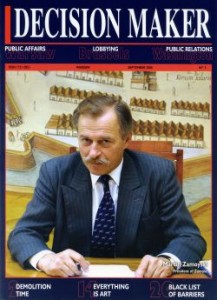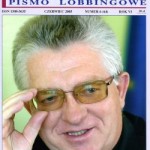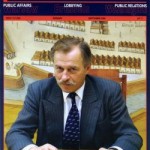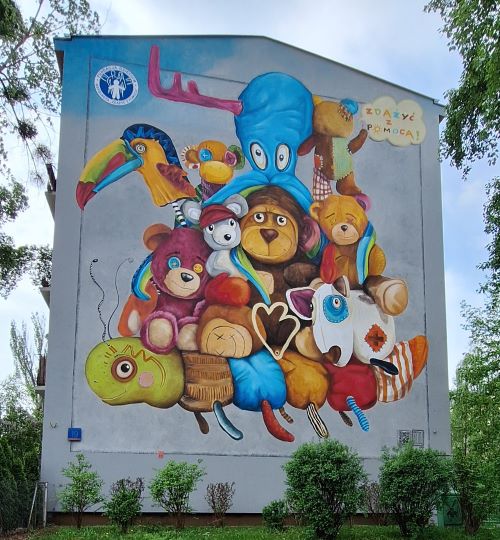18 kwiecień 2008
Winning ideas
Zamość is a special city, as it has been put on the UNESCO register of world heritage sites. When this happend, the authorities in Warsaw stopped showing interest in the affairs of our city and its finances. Those sites, which have been recognized as historical monuments, are not covered by the government`s special protection programme. Kraków is the only city in Poland which receives a fixed annual subvention from the government for saving its heritage. It receives 8,9 mln euro. I would like to see Zamość become a beautiful city: that its inhabitants could be proud of it and have decent housing conditions. I would also like to lower the level of unemployment, which is now 16% – says Marcin Zamoyski, mayor of Zamość.
MARCIN ZAMOYKSI
President of Zamość
talks to Damian A. Zaczek
How do you feel, presiding over a city, founded by your ancestor Jan Zamoyski in 1580?
I certainly feel some pride in being able to revive tradition. However, please note that my ancestors gave the town over to state administration in 1820. So, from that time, the link between the town and my family is only by name: “Zamość” is derived from “Zamoyski”.
When and in what circumstances did you become president of the city?
In 1990 the local councillors hit on the idea of encouraging a descendant of the Zamoyski family to return and take on a public position. My first election as president was made by the city council. It was a big challenge and a huge responsibility for me. Earlier, I had worked in film: for 18 years I was a film cameraman. I had never been involved with administration. However, in 1990, when part of the democratic opposition came to power, people had high hopes, and felt a surge of energy which they thought would allow them to do great things and change their situation completely. I also felt that much would be dependent on me. Since I moved here 16 years ago, I have also held the office of voivode of the Zamojski County and leader of the town council. After a while, I bought a farm in Michałów, one that had belonged to my father. The voit of the Sułów gmina invited me to participate in the local council and I was a member of the gmina’s board for four years.
What is the political structure of the city’s council?
Zamość has 23 councillors. Out of the total, 9 are members of the Democratic Left Alliance (SLD), but 14 councillors of other parties have signed a cooperation agreement and now appear as one alliance. The first leader was Mrs Maria Gmyz from the League of Polish Families (LPR). Please note that party affiliation is of secondary importance in local government. Our local citizens judge us by our work and not by our membership to a particular party. In local government the debate concerns specific issues: there is none of the politics of the type you see in the Sejm. Here, everyone tries to promote their own ideas and strives to obtain support for them from the other council members. Our good cooperation is evidenced, perhaps, by the two-times unanimous passing of the budget. We are held to account for our work.
You have bought a farm. Are you also seeking the return of properties confiscated after 1945 under the communist laws on nationalisation of industry and agricultural reform?
No, because there is no chance of getting them back as long as there is still no legislation in force concerning reprivatisation. For the last 16 years no government has had the courage to finally resolve this issue, although several years ago some initial steps were taken. No government has had the boldness to tell the people: “You will never recover anything, so forget it; or, OK, you won’t get back everything, but you will get this much and that much”. But something really must be said. Despite the legal situation, I have undertaken steps to regain or purchase the palace in Klemensew for a symbolic one zloty. The palace is turning to ruin, the roof is leaking and immediate remedial works are essential. But I have been informed that there is no legal basis on which my plea may be dealt with.
What is the Klemensew Palace used for currently?
Half of the palace is used as a nursing home while the other half stands empty. It was lived in previously by nuns who were running an orphanage. They were taken in together with their children in 1944 by my grandmother, when Russians bombed the building which housed the convent’s orphanage. In 1963, one night the police moved the children to another centre and brought in a group of mentally-ill patients. The nuns then divided the palace into two parts. Afterwards, half of the palace was turned into a nursing home.
We know how the communists wrecked our heritage. Today, we are returning to values of patriotism and national heritage. Can patriotism be taught in school?
It depends on the teachers whether they can not only impart textbook knowledge but whether they can also inspire their children with the spirit of history. It is very difficult to sway young people using simple methods which find their origin in the era of the People’s Republic of Poland. Knowledge has to be conveyed to them in an attractive way. Apart from that, teachers must be held in respect, but most often they are not. It is often difficult for older teachers, who were trained under communism, to adapt to new methods of teaching: they have to fill in the gaps in their knowledge with new facts from Polish history which were previously brushed over or falsified. The family home’s traditions have an effect on upbringing. During the communist times, many people listened to Radio Free Europe and Voice of America, to help them verify the official propaganda. Life then had two sides to it.
How should today’s patriotism be manifested?
In day to day living situations: at home, on the street, at work, in the school, in all personal contacts between people. As well as by observing state and national holidays and by putting up a flag on those occasions. All of this helps to maintain the remembrance of historical events and to build national pride. These are simple demonstrations showing a dedication to Poland, and each citizen should have a sense of duty to his country. However, most Poles believe that the state should provide them with everything, requiring nothing of them in return.
The historic city of
Zamość is a good place to teach history and patriotism. Are the current authorities interested in taking advantage of this opportunity?
Yes, Zamość is a special city, as it has been put on the UNESCO register of world heritage sites. When this happened, the authorities in Warsaw stopped showing interest in the affairs of our city and its finances. Those sites, which have been recognized as historical monuments, are not covered by the government’s special protection programme. Kraków is the only city in Poland which receives a fixed annual subvention from the government for saving its heritage. It receives 35 mln PLN.
What are people like in Zamość and in the region?
They have been living here for generations and they are marvellous: frank and open. It is really worthwhile working with them and for them.
Did they immediately accept you, those 16 years ago?
Yes, I think so. They have elected me to various positions in the city, the poviat and the gmina. I had seven candidates competing against me in the city’s presidential election. The candidate of the left ran against me in the second round. The people elected me, although I had only been living here for 12 years. Maybe my surname helped?
What problems are you faced with in Zamość?
The city was, till recently, rather neglected. We do not have any industry, so our income, including from tourism, is not very big. Thanks to European Union funds, which we have been able to add to the city’s own funds, we are beginning to see an improvement in the look of the city and the quality of life of its dwellers. We are modernising the whole of the city’s public transport system. We have bought a fleet of Solaris gas-powered buses, which are nearly three times cheaper to run and do not pollute the environment. We also have now a modern sewage treatment plant and we are expanding the network of sewers. In addition, we have prepared a detailed plan to regenerate the city: we want to recreate part of the city’s fortifications, to restore the cathedral and the 17th century Franciscan church, which used to be a warehouse, a folk centre and a cinema. Only after 1990 was the church returned to the Franciscans. The city’s cathedral requires significant expenditure.
What about housing?
In 1939, 40% of Zamość’s inhabitants were Jews. The wealthiest among them left the city with the Soviet army when the Germans armies marched in. Most of them survived. They returned in 1946 and 1947 and sold their homes. In those days, there were huge shortages of accommodation so the communist authorities moved homeless families into other people’s apartments. These people paid no rent, so the buildings fell into disrepair, while the owners were unable to maintain their properties. The state then took over these degraded properties, and later they passed over to the city. Today these buildings require complete renovation.
How is Zamość treated by the voivodeship authorities?
After the local administration reforms of 1979, when the Zamojskie Voivodeship was created, the city used to receive funds from central government. Currently, Zamość lies within the border of the Lubelskie Voivodeship and the budget is distributed from the capital city of the voivodeship which is Lublin. One can say that we are not Lublin’s favourites. They refer to us there as the ”Zamość lords”, or the ”hetmen”, which is supposed to imply that we have ambitions above our station. We laugh at this as we do not intend to compete with Lublin which is a great educational and cultural centre. We don’t want to take anything from them but we expect partnership.
There are no conflicts, but there must be rivalry between Za
mość and Lublin? Over what?
Over the airport, for instance. We have a small airport in Zamość, which we would like to enlarge to enable it to receive sports planes and air taxis carrying up to 20 passengers. We have prepared plans: we have everything apart from money, but that is shared out by Lublin. However, Lublin has a small airfield nearby in Świdnik run by the aero club. The President of Lublin and the Voivode support the idea of expanding that airfield, but the Office of the Marshal has decided that it is too small and they would like to build a new one at a different location. The decision has become deadlocked.
What are your hopes for the future?
I would like to see Zamość become a beautiful city: that its inhabitants could be proud of it and have decent housing conditions. I would also like to lower the level of unemployment, which is now at 16% and about average for the country. We have prepared a programme to encourage the youth who have left the city to study or gone abroad, to come back. The Employment Office has earmarked several hundred thousand zloties to help young people set up their own businesses. We have noticed recently that this idea is beginning to bear fruit. The “migrants” are gradually returning.
Thank you for talking.














MY PERSPECTIVE
Demolition time
The Kaczyński brothers have announced the creation of the 4th Republic. However, it looks like they are currently at the stage of completely dismantling and destroying the structures set up after the fall of communism. więcej...